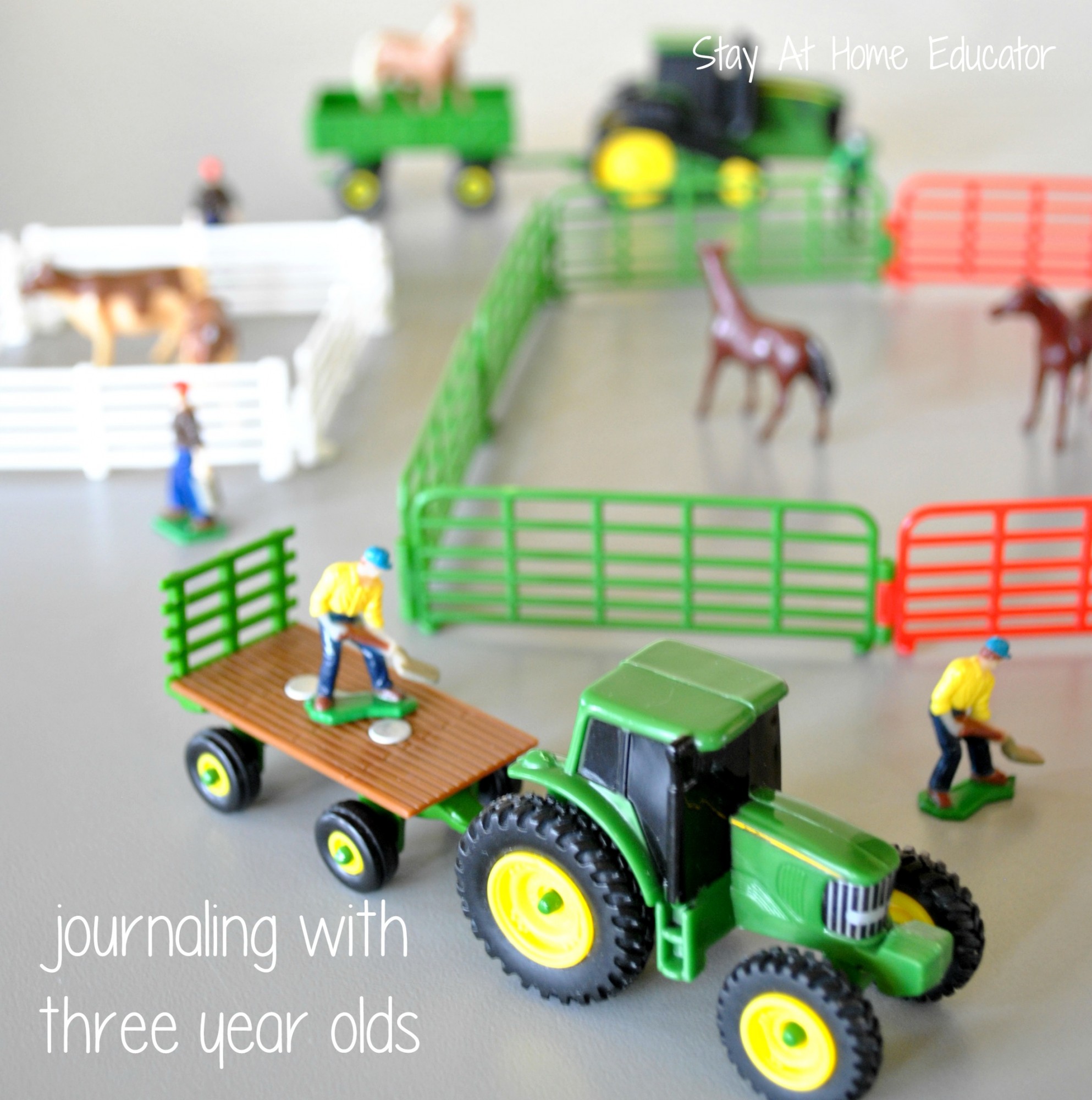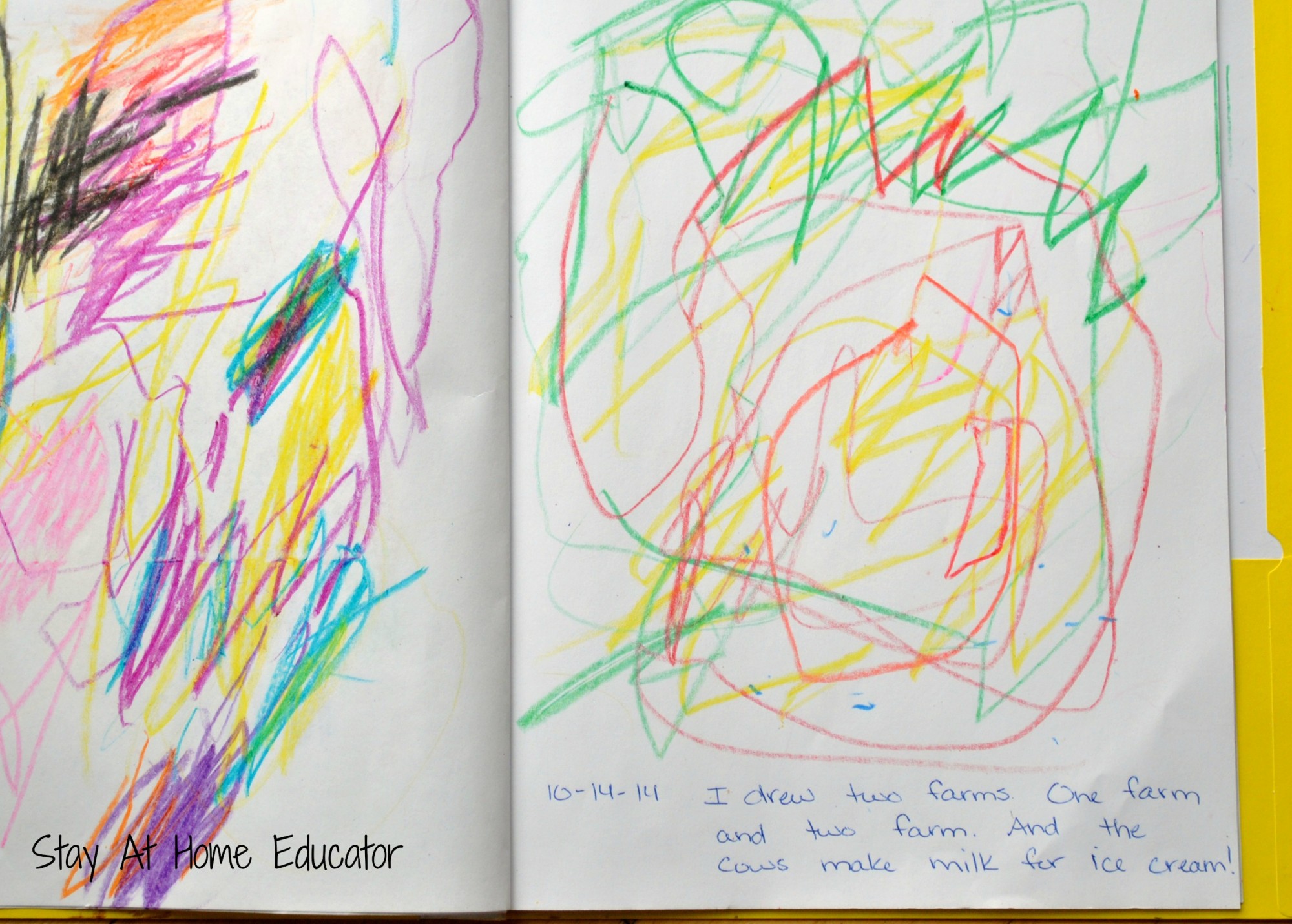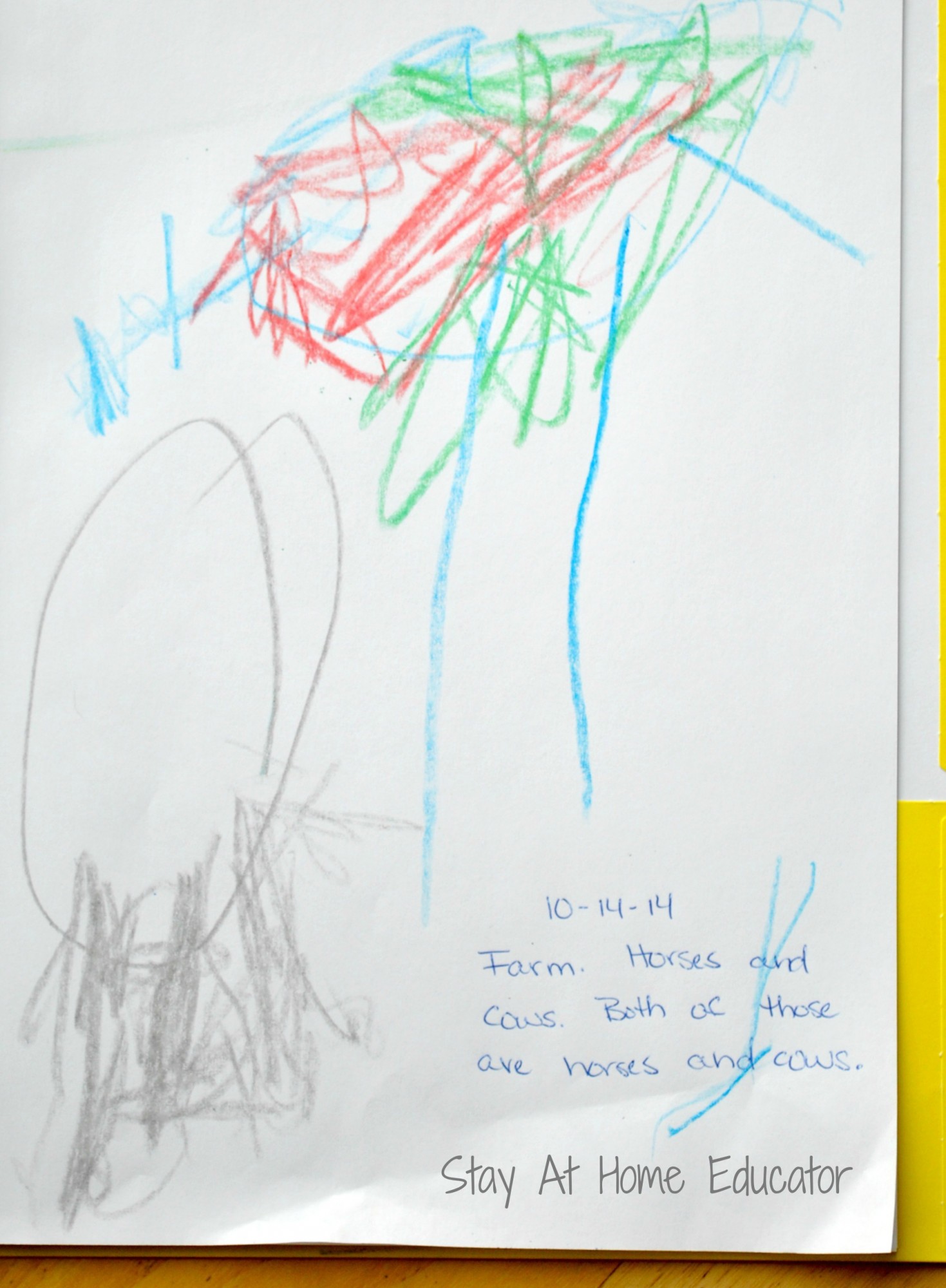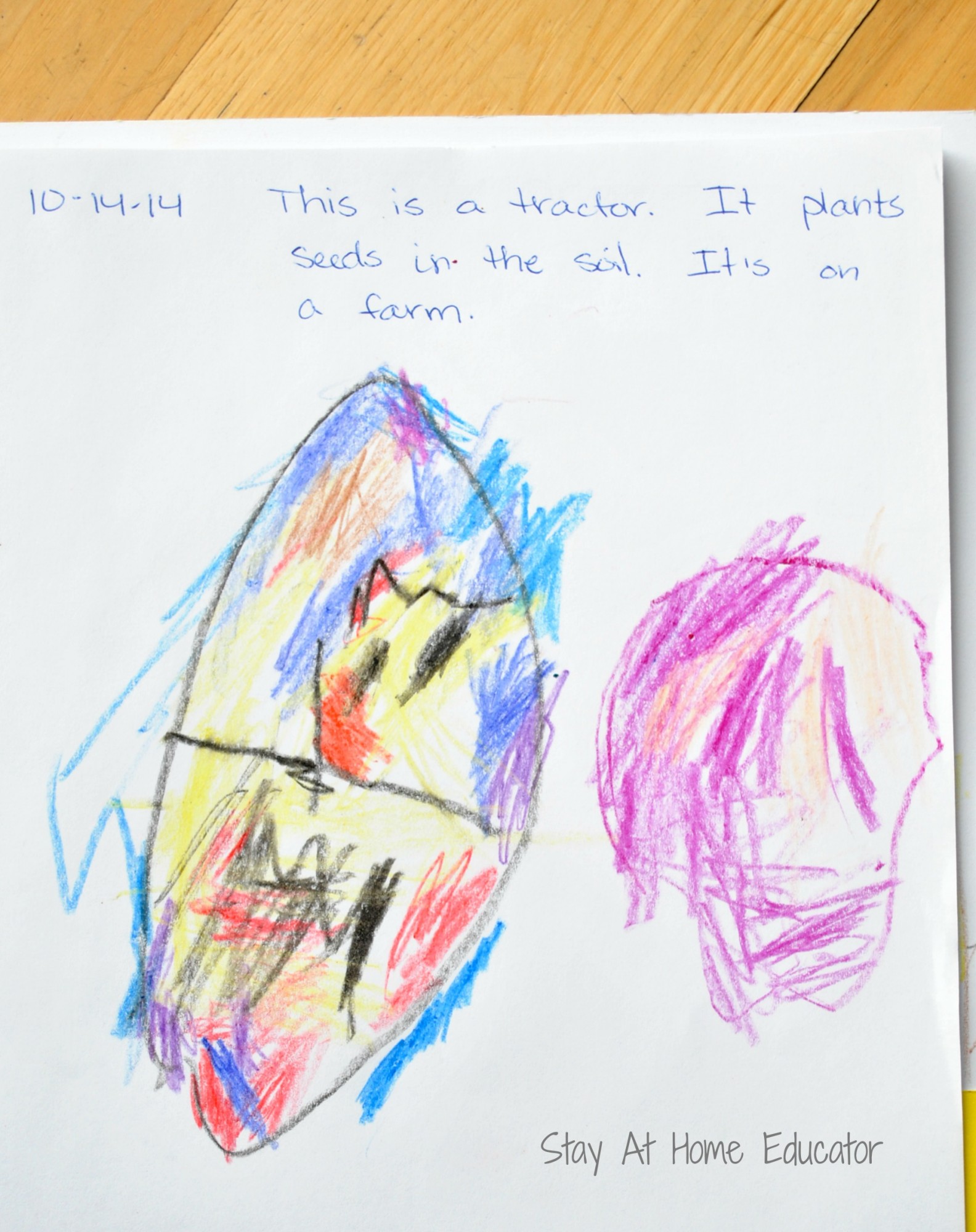Preschoolers love to tell stories. Journaling with preschoolers is always a fun way to hear those stories. Not only does it invite children to be creative and use their own experiences to share ideas, journaling with preschoolers is a step toward further developing emergent writing skills in addition to making text to speech connections.
 Writing practice in preschool may not look like what most would expect. There should be no (or very little) tracing sheets, letter formation practice, or “do what I do,” writing practice. It is a lot, and really I mean mostly, fine motor practice. Threading beads, lacing cards, twisting nuts and bolts, picking up water beads, scooping and pouring, and so on. This does not mean, however, that writing practice in preschool should eliminate all pencil and paper practice. Instead, preschool teachers must focus that pencil and paper writing practice into something meaningful to the students, like telling stories through journaling.
Writing practice in preschool may not look like what most would expect. There should be no (or very little) tracing sheets, letter formation practice, or “do what I do,” writing practice. It is a lot, and really I mean mostly, fine motor practice. Threading beads, lacing cards, twisting nuts and bolts, picking up water beads, scooping and pouring, and so on. This does not mean, however, that writing practice in preschool should eliminate all pencil and paper practice. Instead, preschool teachers must focus that pencil and paper writing practice into something meaningful to the students, like telling stories through journaling.
Please join me regularly via E-mail in the right sidebar, Facebook, Twitter @StayAtHomeEdu, and Pinterest. This post may contain Amazon affiliate links. Read my full disclosure policy here.
For this journaling activity, I set up a farm themed “still life.” Using some tractor and horse toy sets, I set the toys up in a inviting and realistic way. I used pieces from this John Deere Value Set, however any set of thematic toys could work.
 Prior to this journaling activity, we had read several books about farming. The purpose of this was not only to incorporate more literacy into our preschool day, but also to provide some incredible background knowledge for the children. This aided their story telling capabilities.
Prior to this journaling activity, we had read several books about farming. The purpose of this was not only to incorporate more literacy into our preschool day, but also to provide some incredible background knowledge for the children. This aided their story telling capabilities.
After setting up the farm still life, I invited the children to join me at the preschool table. As always, I allowed them to play with the small world I’d created. Allowing the children to freely play before the activity is an important step that can’t be left out. This free play time allows the children to “get their play out,” (as in, then they won’t feel compelled to play during journaling time, instead they will feel compelled to write), and this free play is also a time for children to practice using the farm vocabulary we’ve been learning and hearing in all the books we’ve been reading. In essence, the journaling begins as soon as the play does.
This is because while the children are playing with the set-up, they are telling stories. They are using their background knowledge and experiences to construct meaning from the toys. If you ever listen to a child who is playing pretend, you will hear a clear story line. That story line is what I want my students to record in their journals.
After a fair amount of time, probably twenty minutes or more, the children have been well settled into their play. At this point I set out their journals with some crayons and invite them to write or draw their stories in their journals.
This is what comes of journaling with preschoolers.
 I want to validate their stories, as so I record them exactly as they are told. You can see a range in development within these stories, which is completely normal.
I want to validate their stories, as so I record them exactly as they are told. You can see a range in development within these stories, which is completely normal.
 Remember, this activity was done with three year olds, some of them having just turned three a few months prior. Their writing resembles more scribbling than letters or actual figures, but to my preschoolers, this is real writing. To me, their teacher, it is real writing because I can see how they are trying to convey information via their drawings.
Remember, this activity was done with three year olds, some of them having just turned three a few months prior. Their writing resembles more scribbling than letters or actual figures, but to my preschoolers, this is real writing. To me, their teacher, it is real writing because I can see how they are trying to convey information via their drawings.
 Once preschoolers reach a certain point in reading and writing development, they may begin to say things like, “But I don’t know how to write.” To this I respond, “But you can write. Drawings can tell stories, and I always like to see the stories you draw.” That is always great motivation for that student who is transitioning from writing stories through drawings into using miscellaneous letters to tell stories.
Once preschoolers reach a certain point in reading and writing development, they may begin to say things like, “But I don’t know how to write.” To this I respond, “But you can write. Drawings can tell stories, and I always like to see the stories you draw.” That is always great motivation for that student who is transitioning from writing stories through drawings into using miscellaneous letters to tell stories.
Journaling with my preschoolers was a new goal I had set for myself for this new school year. We have had a fair amount of success. We journal at least once in every four days of my program, which means about twice a month in my two day a week program.
For more information about journaling with preschoolers, please see some of the posts below by some of my fellow bloggers.
Journals With Three Year Olds by Teaching 2 and 3 Year Olds
Preschool Journaling by What Do We Do All Day?
Journal Writing by Still Playing School
Poetry Journals by Buggy and Buddy
Creating and Using an Observation Journal by Kitchen Floor Crafts

I’m Sarah, an educator turned stay-at-home-mama of five! I’m the owner and creator of Stay At Home Educator, a website about intentional teaching and purposeful learning in the early childhood years. I’ve taught a range of levels, from preschool to college and a little bit of everything in between. Right now my focus is teaching my children and running a preschool from my home. Credentials include: Bachelors in Art, Masters in Curriculum and Instruction.

I always enjoy your articles Sarah, I always learn so much!! Question for you: what age do you start teaching “formal” or tracing of letters?
After the kiddies turn four, I have them start tracing their name. We do things to work on correct pencil grip and other fine motor skills, but I my instruction of actual letter formation is very little to practically none. We draw in sand and such to practice letter writing, but I do not insist on specific formation. I have letter cards for the students to look at and they experiment with how they think the letter might be formed. There is such a wide range of capabilities in the skill of letter writing that I don’t want to stress out my students by introducing it when they are not ready. If a child shows interest, then I will teach him. Otherwise, we stick to our own names and fun fine motor activities.